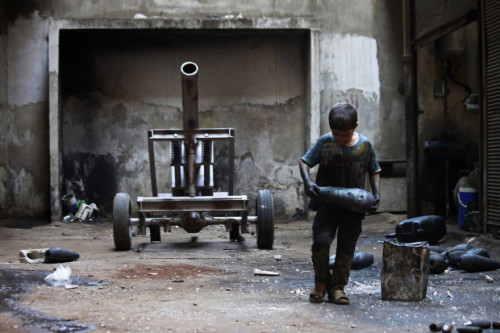On Thursday, EA featured a report on the displaced Syrians who wait in camps at the Turkish border for a chance to leave the country. But what are the prospects for those who do manage to enter Turkey?
Lina Sergie Attar writes for Syria Deeply of her visit to Reyhanli, 5 km (3 miles) inside Turkey.
Since 2012, the town’s population has more than doubled with Syrian refugees. The parks are filled with Syrian children, the streets with Syrian families and the main street is dotted with distinctly Syrian shops. Arabic signs over fast food shacks and grocers invite the booming Syrian refugee population, and entice the constant stream of Syrian expats like us inside for a taste of home — with a side story of loss.
While Reyhanli has been caught in the violence of Syria’s civil war — a car bomb in May 2013 killed 51 people — some Syrians have achieved prosperity, albeit limited, in the neighbourhood:
We visit a family from Idleb. The eldest son used to own a full bakery but now works using only a portable electric saj, a half dome-shaped hot surface for making flatbreads. His younger sister, 15-year-old Hiba, kneads and rolls out uniform circles of dough. He expertly tosses and stretches the dough into paper-thin rounds that immediately bubble on the searing surface.
He covers some rounds with homemade mixtures of cheese, or zaatar, or red pepper paste. Each bite is perfect.
The makeshift storefront occupies a nook in front of his rented apartment building, marked off with a blue plastic curtain, and there is no sign. The space reeks of illegality. His Turkish landlord has allowed him, for now, to operate here. The saj place seems to be a success story in the making. Maybe this time next year they will have a bakery.
But that hope cannot erase Attar’s concerns for the displaced Syrian children:
We leave with a sense of hopefulness for the fledgling business except for the one fact that brings us here — Hiba does not know how to read. We hope she will persevere through the accelerated literacy program she just started in June at the Salam School for Syrian refugees. Otherwise, she will be condemned, at best, to a future of rolling dough — not by choice but by cruel circumstance.
That concern for Syria’s children has been documented by photojournalist Hamid Khatib. Working in Aleppo, Syria’s largest city, Khatib has captured on camera the life of children such as Issa — a 10-year-old boy who helps his father build weapons.
Commenting on the blog, “From Inside: A Diary of Syria”, Hamid explains:
Issa’s story is different from any other thing I have worked on. I managed to do something. To get Issa’s voice out to the world. When I told him about the success the series had and how people were talking about his story, he was extremely happy.
Yet the story itself feels different and more coherent to me. It makes me feel so small compared to a child working in this line of work either for a small pay or just to help his father. A boy who had to leave his school because of the war only to live a life surrounded by weapons.
The photographer concludes, “It’s never normal to see a child carrying a mortar shell and unable to walk because of his injured foot.”


